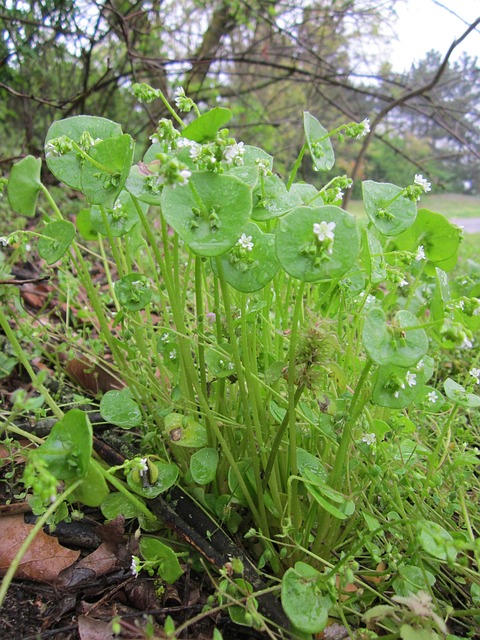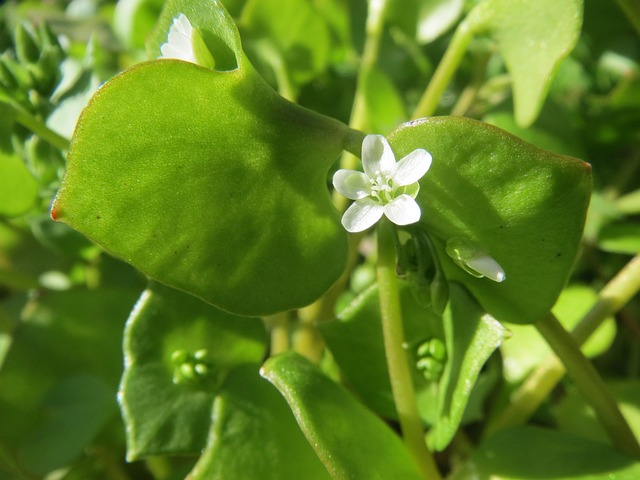Claytonia, commonly known as miner’s lettuce, is a cold-hardy, leafy green native to North America, particularly the western regions. Its botanical name is Claytonia perfoliata, and it is named miner’s lettuce because it was consumed by miners during the California Gold Rush as a source of vitamin C to prevent scurvy. This low-growing, succulent plant is appreciated for its tender, mild-flavored leaves and nutritional value. The circular, cup-shaped leaves with tiny, white or pinkish flowers in the center add an ornamental touch to the garden. It thrives in cool weather, making it an ideal crop for winter or early spring gardening. Here’s how to grow and care for claytonia in a home garden.
Characteristics of Claytonia
Miner’s lettuce is a unique, leafy green that stands out due to its attractive, round leaves. It forms a basal rosette of bright green leaves that are soft and succulent, with a delicate, mild flavor. The leaves are typically spoon-shaped or rounded, with a flower stalk emerging from the center. Atop the stalk, a pair of fused leaves form a circular shape, known as the “perfoliate” leaf, through which the stem grows. Small, star-shaped flowers emerge from the middle of this leaf during blooming. Claytonia is highly nutritious, rich in vitamins A and C, making it a healthy addition to salads, sandwiches, or lightly cooked dishes.
Miner’s lettuce is incredibly cold-hardy, capable of growing in temperatures as low as 20°F (-6°C), and is well-suited to winter gardening. It can tolerate light frosts and even snow, making it an ideal crop for gardeners who want to extend their growing season. While it does best in cooler climates, it can also be grown in spring or fall in warmer regions.

How to Grow Claytonia
Planting Time and Location
The best time to plant claytonia is in late summer for a fall harvest or early spring for a spring crop. In mild winter climates, it can be grown throughout the winter. Choose a location in your garden that receives partial shade to full sun. Although miner’s lettuce tolerates some sunlight, it performs best in cooler conditions with light shade, especially in regions where winters are mild. The partial shade helps keep the plant from bolting (going to seed) too quickly when temperatures rise.
Soil Preparation
Claytonia is not a particularly demanding plant when it comes to soil, but it does prefer well-draining, fertile soil rich in organic matter. Prepare the soil by loosening it to a depth of at least 6-8 inches and mix in some compost or well-rotted manure to provide nutrients. The soil pH should ideally be between 6.0 and 7.0, which is slightly acidic to neutral, but the plant can tolerate a wider range of pH levels.
Sowing Seeds
Sow claytonia seeds directly in the garden, as they do not transplant well due to their delicate roots. Scatter the seeds thinly on the soil surface, then cover them lightly with a fine layer of soil or compost, no more than 1/4 inch deep. Seeds can be sown in rows or broadcast over a bed. To ensure a continuous harvest, plant seeds every 2-3 weeks during the growing season. Keep the soil moist, and germination should occur within 7-14 days. In colder areas, use row covers or cloches to help protect young seedlings from extreme cold.
Spacing and Thinning
Once the seedlings have grown to about 2 inches tall, thin them to 4-6 inches apart. This spacing will give each plant enough room to develop fully. The thinned seedlings can be used as microgreens in salads or as an edible garnish.
Watering
Claytonia prefers consistently moist soil but is fairly drought-tolerant once established. Water the plants regularly, ensuring the soil does not dry out completely. Aim for an even level of moisture to prevent the leaves from becoming tough. Avoid overwatering, as claytonia does not thrive in soggy conditions, which can lead to root rot or mildew.
Mulching
Applying a layer of mulch around the plants helps to retain moisture, regulate soil temperature, and suppress weeds. Use organic mulch, such as straw or leaf mold, which will also contribute to the soil’s fertility as it breaks down. Mulching is especially beneficial during warmer weather to keep the soil cool and moist.

Caring for Claytonia
Fertilizing
Claytonia does not have high nutrient demands. If you have already amended the soil with compost, additional fertilizer may not be necessary. However, if you notice the plants are not growing vigorously or the leaves appear pale, a light application of a balanced organic fertilizer can help. Avoid over-fertilizing, as excessive nitrogen can cause the plant to bolt prematurely.
Pest and Disease Control
Miner’s lettuce is relatively resistant to pests and diseases. However, slugs and snails may occasionally feed on the leaves, especially in damp conditions. Handpicking these pests or using organic slug repellents can help protect your crop. Ensure proper spacing and air circulation to reduce the risk of fungal diseases, such as downy mildew, which can develop in overly wet conditions.
Harvesting
Claytonia is ready to harvest when the leaves are tender and about 2-4 inches in diameter. You can start harvesting individual leaves once the plant is well-established, or cut the whole rosette just above the base to encourage new growth. The “cut and come again” method allows for continuous harvesting over several weeks. The young leaves are the most tender and flavorful, while older leaves may develop a slightly bitter taste. Harvesting regularly helps prevent the plant from bolting, extending its productive life.
Growing Claytonia in Containers
Miner’s lettuce also performs well in containers, making it suitable for small gardens, balconies, or patios. Choose a container that is at least 6 inches deep, with good drainage. Use a high-quality potting mix enriched with compost. Water the container-grown claytonia regularly, as potted plants tend to dry out faster than those in the ground. Place the container in a location with partial shade or indirect sunlight to avoid overheating.
Extending the Growing Season
To grow claytonia throughout the winter, especially in colder climates, you can use season extension techniques. Row covers, cold frames, or unheated greenhouses can provide the necessary protection from severe frosts and snow. These structures create a microclimate, trapping heat and keeping the plants warmer than the outside temperature. Ventilate cold frames on sunny days to prevent overheating and condensation buildup, which could lead to mildew.
Using Claytonia in the Kitchen
Claytonia is versatile in the kitchen. Its tender leaves and mild flavor make it perfect for fresh salads, either as the main ingredient or mixed with other greens. It can also be added to sandwiches or used as a garnish. The leaves can be lightly sautéed or steamed for a nutritious side dish. Since it’s high in vitamins A and C, miner’s lettuce is a healthy addition to winter meals.
Claytonia, or miner’s lettuce, is a unique and easy-to-grow winter green that adds both nutrition and beauty to the home garden. Its ability to thrive in cool weather and tolerate frosty conditions makes it an ideal choice for winter and early spring gardening. By sowing seeds directly in well-prepared soil, providing consistent moisture, and using simple season-extension techniques, you can enjoy fresh, homegrown miner’s lettuce even in the coldest months. Whether grown in the ground or containers, claytonia is a rewarding and low-maintenance crop that brings fresh flavors to your kitchen during the off-season.
Lettuce Growing Hub
Cluster Posts
🌱 Getting Started: Planting & Varieties
- Types of Lettuce: A Gardener’s Guide to 5 Main Types
- Lettuce Planting Calendar by Season and Region
- Lettuce Seed Starting Tips
- How to Start, Lettuce Indoors: Supplies, Timing, Tips
- How to Plant Lettuce Outdoors: Direct Sowing Tips
- Where to Grow Lettuce: Beds, Containers, Indoors & More
- Growing Lettuce in Containers
- Best Companion Plants for Lettuce: And What to Avoid
🥬 Seasonal Growing Guides
- How to Grow a Fall Lettuce Crop for Cool-Weather Harvests
- Heat-Tolerant and Bolt-Resistant Lettuce Varieties for Summer
- Best Lettuce Varieties for Winter and Cool Weather Growing
- Lettuce Care from Seed to Harvest: A Month-by-Month Guide
💧 Lettuce Care & Maintenance
- Watering Lettuce: How Much and How Often
- Feeding Lettuce: When and How to Fertilize
- Thinning and Spacing Lettuce for Optimal Growth
- Preventing Lettuce Bolting: How to Keep Lettuce From Going to Seed
🌿 Harvest & Beyond
⚠️ Troubleshooting & Special Topics



